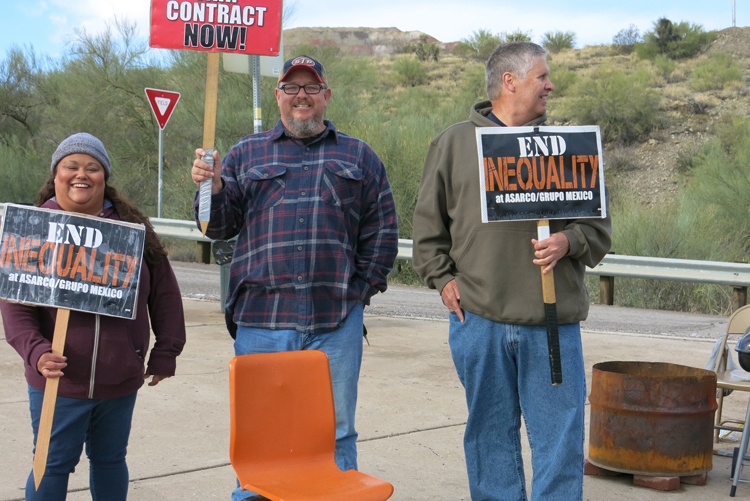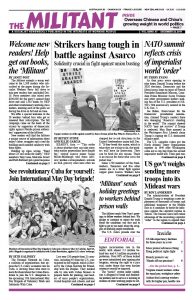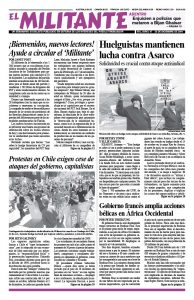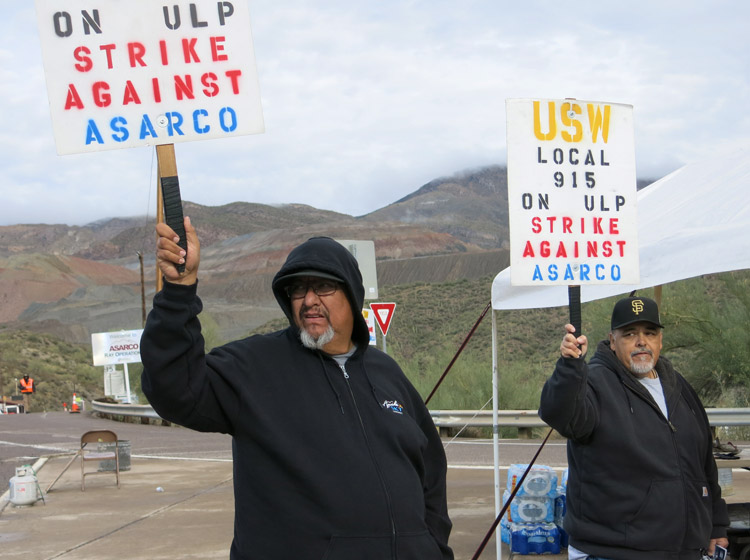KEARNY, Ariz. — “This strike is about whether they can take away what earlier generations have fought for,” retired Asarco miner Susan Miller-Middaugh told these Militant worker-correspondents outside an IGA grocery store here after we stopped her to ask directions to the United Steelworkers union hall Dec. 8. “If they break this union, which is what they are trying to do, the workers will have no protection. They can be fired for any reason. There is no excuse for those who cross the picket line.”
Some 1,700 members of the Steelworkers, Teamsters and five other unions are in a bitter fight against copper giant Asarco. Workers have been on strike since Oct. 13 at Asarco’s Ray Mine, a short drive north of here; at its smelter complex in nearby Hayden; at its Mission and Silver Bell Mine complexes near Tucson and at its refinery in Amarillo, Texas.

Asarco is out to bust the union. Asarco — which is owned by Grupo Mexico, one of the largest copper companies in the world — imposed its “last and final offer” Dec. 2, in other words, the company says no more negotiations. That “offer” includes a pay freeze for nearly three-quarters of the workers, a slight raise for the highest paid, a freeze on pensions, doubling or tripling health care costs and weakening union protections on the job.
“If you support the strike, I need to give you some strike support posters,” said Miller-Middaugh, who keeps a stash of placards in her car. She tells us that in 1973 she was the first woman to work in the Ray Mine, Asarco’s largest complex, with some 800 workers.
Before the strike there were many women in the mine, she said, enough that there were all-women crews. When told that Stone was bringing a solidarity card from workers at the Walmart where she works, and that Garcia had worked at a Kennecott copper smelter in Utah in the early 1990s, she insisted on driving with us to the union hall.
The company claims that 340 workers have crossed the picket line. This includes about 100 workers, the majority, at the Silver Bell Mine — Asarco’s smallest complex. The company has gotten some production going at the Ray Mine and Mission complexes, using supervisors, some workers who have crossed the line, nonunion contractors and newly hired scabs.
But the strike has forced Asarco to shut down the smelter and concentrator complex in Hayden and its Amarillo refinery. The company is stockpiling copper concentrate in Hayden produced from its mines, but will soon run out of storage space if the bosses can’t get the smelter running again. Asarco just recently finished refurbishing the smelter, spending $229 million.
In a conference call with its investors a couple weeks into the strike, Grupo Mexico said it planned to get production up to 100% at the Mission Mine by the end of the year and restart at the Ray mill by January. So far, the strike has upset those plans.
Strikers are picketing outside all the Asarco facilities around-the-clock, seven days a week. “We are here for as long as it takes,” Rico Lopez told us when we joined the picket line at the Ray Mine.
Lopez is a shovel and drill mechanic, as is his older brother Adrian Lopez. They come from four generations of copper miners.
‘Asarco tried to divide us for years’
“This company has been trying to divide us for years,” Adrian Lopez said. “Starting 10 years ago, they took away the bonuses of the new hires, something the union had fought for and won. Then they took away the defined pensions of workers with less seniority, substituting 401(k)s.

“Now they want to divide us by refusing wage increases to the majority, while giving raises to others,” he said. “We’re saying, no.” To drive this point home, several picketers carried signs saying, “End inequality at Asarco/Grupo Mexico.”
Strikers said that some of those who crossed the picket line are workers from outside the area. “They haven’t grown up with the idea of union,” said Adrian Lopez. “Some others aren’t crossing, but they haven’t become active in the union. We tell them we need to stand up or we’ll keep going backwards.”
For more than a century eastern Arizona has been a center of bloody battles between copper bosses and the miners. Rico Lopez said they grew up in this small town of 2,000 where generations of family members fought for the union and walked picket lines as children. Both brothers said that before the strike they had spent time discussing with workers about what had been won and defended through the union, urging them not to cross the picket line.
Solidarity crucial
Strikers welcomed the solidarity from over 40 workers at the Walmart outside of Oakland, California, who wrote messages of support and encouragement next to their signatures on the solidarity card. Some strikers said they’ve gotten jobs at an area Walmart to help see themselves through the strike.
The strikers are buoyed up by the support they get in Kearny and nearby copper towns, where almost everyone has a family member or friend who has or is working in copper — from the waitresses at the Old Time Pizza to the small businesses people who put strike support signs in their windows.
Not everyone supports the strike. “It’s polarized,” said Richard Perez, an SX maintenance worker at the mine. “I grew up here being union, knowing that you are on one side or the other, there’s no in between.” Perez was volunteering at the Steelworkers union hall to help fellow strikers get assistance.
The strikers need support, including solidarity messages, visits to reinforce picket lines and donations to strike funds and for Christmas. For strikers at the Ray Mine and Hayden Smelter in Kearney and Hayden, send contributions and messages of support to USW Local 915, Strike Assistance, P.O. Box 550, Kearny, AZ 85137. For strikers at the Mission and Silver Bell complexes outside of Tucson, send donations to the Pima Area Labor Federation Community Services via paypal.me/palfcommunityservice. Solidarity messages to the strike can be sent via palfchair@gmail.com.


